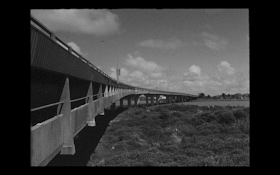When Paul Janman and I decided to make a documentary film about Auckland's Great South Road several years ago, I imagined that we'd hit the streets of South Auckland for a few weeks, cool our heels in the editing suite at the back of Paul's house for a few days, and emerge with a feature-length film. I was naive. Shortages of funding and time, fluctuations in enthusiasm and changes in perspective have all complicated our work.
But even if it hasn't delivered a movie, what we've taken to calling 'the Great South Road project' has permutated in some interesting and unexpected ways. Along with the cimenatographer and professional retrofuturist Ian Powell, Paul and I have contributed images of and words about the Great South Road to three art shows. Paul and Ian have lately been filming the Papakura section of the Great South Road, after being asked to contribute footage of that suburb to this year's Auckland Festival. And this week Paul and I will be taking a group of drama students from Unitec on a guided tour of Mangere Bridge, and then showing them Merata Mita's film about the epic industrial dispute that delayed the construction of that bridge in the 1970s. Sociologist Dave Bedggood will be joining us to remember the political and economic crises of the '70s, and the issues at dispute during the Mangere strike.
Paul and I got interested in Mangere's bridge last year. We had been invited to contribute to the Other Waters festival, which was intended to retrieve some of the history of the Manukau harbour and its environs. Although the Mangere Bridge was not literally on the route of the Great South Road, we decided that it had some of the same genealogy - the water it crossed had, in the nineteenth century, been a de facto border between Maori and Pakeha worlds, and in the twentieth century the neighbourhoods it had connected had boasted the same politically conscious working class culture we were trying to document in suburbs like Otahuhu and Papatoetoe.
I spent hours hacking through old newspapers, and discovered a series of events - the banning of Maori from the old Mangere Bridge in 1912, after the outbreak of smallpox in their community; the persecution, a year later, of Onehunga's municipal brass band, after its buglers and trumpeters insisted on joining the marches of the 'Red' Federation of Labour; the pursuit and arrest of opium dealers along the same bridge in the 1920s, and the raiding of Chinese homes at the southern end of the bridge by cops looking for drugs; calls in the 1930s for the conversion of the bridge into a sort of dam, the draining of the allegedly unhealthy waters of the upper Manukau harbour, and the creation of a 'garden suburb' on reclaimed land - that Paul and I discussed when we gave a guided tour of the Mangere Bridge back in November, during the Other Waters festival.
While Paul and I were walking and talking, Ian Powell crept and knelt in the shadows of the bridge's underpass, fiddling with his archaic camera; here are some stills from the film he shot. If you look carefully, you can see the author of one of New Zealand's most famous songs and some of its most memorable books of poetry tinkering with the peeriscope that Paul installed on the bridge.




No comments:
Post a Comment